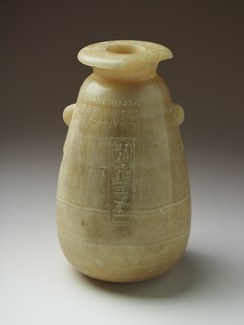Jar with Multilingual Inscriptions

Produced in Egypt during the reign of the Persian king Xerxes (r. 486–465 BCE), this jar attests to the multilingual milieu that characterized Egypt before the arrival of the Ptolemies. Indeed, it is incised with the phrase “Xerxes the Great King” written in Old Persian, Elamite, and Akkadian (three Ancient Near Eastern languages that use a cuneiform alphabet), as well as Demotic and Hieroglyphs.
G. D. Scott III. Ancient Egyptian Art At Yale. Boston, 1987. 145, no. 79.
I. Shaw. Inscribed Stone Vessels as Symbols of the Egypto-Achaemenid Economic Encounter. In: A. Hudecz, M. Petrik eds. Commerce and Economy in Ancient Egypt. Proceedings of the Third International Congress for Young Egyptologists 25-27 September 2009, Budapest. BAR International Series 2131, 2010. 113-117